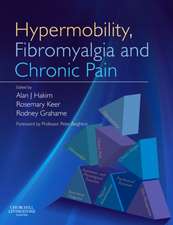Economics and Preventing Healthcare Acquired Infection
Autor Nicholas Graves, Kate Halton, William Jarvisen Limba Engleză Hardback – 2 iun 2009
| Toate formatele și edițiile | Preț | Express |
|---|---|---|
| Paperback (1) | 362.72 lei 43-57 zile | |
| Springer – 29 oct 2010 | 362.72 lei 43-57 zile | |
| Hardback (1) | 369.45 lei 43-57 zile | |
| Springer – 2 iun 2009 | 369.45 lei 43-57 zile |
Preț: 369.45 lei
Preț vechi: 388.90 lei
-5% Nou
Puncte Express: 554
Preț estimativ în valută:
70.72€ • 76.84$ • 59.44£
70.72€ • 76.84$ • 59.44£
Carte tipărită la comandă
Livrare economică 21 aprilie-05 mai
Preluare comenzi: 021 569.72.76
Specificații
ISBN-13: 9780387726496
ISBN-10: 0387726497
Pagini: 165
Ilustrații: XIII, 161 p.
Dimensiuni: 155 x 235 x 13 mm
Greutate: 0.44 kg
Ediția:2009
Editura: Springer
Colecția Springer
Locul publicării:New York, NY, United States
ISBN-10: 0387726497
Pagini: 165
Ilustrații: XIII, 161 p.
Dimensiuni: 155 x 235 x 13 mm
Greutate: 0.44 kg
Ediția:2009
Editura: Springer
Colecția Springer
Locul publicării:New York, NY, United States
Public țintă
Professional/practitionerCuprins
Economics.- Health Economics.- Economic Appraisal: A General Framework.- Economic Appraisal: The Nuts and Bolts.- Changes Arising from the Adoption of Infection Control Programs.- Measuring the Cost of Healthcare Acquired Infections.- Measuring the Cost of Implementing Infection Control Programs.- Preventing HAI and the Health Benefits that Result.- Dissecting a Published Economic Appraisal.- Economic Facts and the Infection Control Environment.
Recenzii
From the reviews:
"This book on the cost of healthcare-associated infectious is written from an economic rather than an accounting perspective, a difference that is explained in detail … . It is written for infection-control personnel and infectious disease practitioners with no prior knowledge of economics. … Graduate and professional students and researchers in health-related fields with an interest in healthcare epidemiology may find this book a helpful introduction. … it is easy to read and clearly organized." (Linnea A. Polgreen, Doody’s Review Service, August, 2009)
"This book on the cost of healthcare-associated infectious is written from an economic rather than an accounting perspective, a difference that is explained in detail … . It is written for infection-control personnel and infectious disease practitioners with no prior knowledge of economics. … Graduate and professional students and researchers in health-related fields with an interest in healthcare epidemiology may find this book a helpful introduction. … it is easy to read and clearly organized." (Linnea A. Polgreen, Doody’s Review Service, August, 2009)
Notă biografică
Nicholas Graves is a Senior Research Fellow in Health Economics at the School of Public Health, Queensland University of Technology. He is also a Senior Lecturer in the Department of Infectious Diseases at the Princess Alexandra Hospital, Australia.
William Jarvis is a well-known figure in infection control. He was formerly Chief of the Epidemiology Branch at the CDC, as well as Director of the Hospital Infections Program at the CDC. He is a past President of The Society for Healthcare Epidemiologists of America (SHEA), and is currently Vice-President of the Association for Professionals in Infection Control (APIC).
William Jarvis is a well-known figure in infection control. He was formerly Chief of the Epidemiology Branch at the CDC, as well as Director of the Hospital Infections Program at the CDC. He is a past President of The Society for Healthcare Epidemiologists of America (SHEA), and is currently Vice-President of the Association for Professionals in Infection Control (APIC).
Textul de pe ultima copertă
Economics and Preventing Healthcare Acquired Infection
Nicholas Graves, Kate Halton, and William Jarvis
The evolution of organisms that cause healthcare acquired infections (HAI) puts extra stress on hospitals already struggling with rising costs and demands for greater productivity and cost containment. Infection control can save scarce resources, lives, and possibly a facility’s reputation, but statistics and epidemiology are not always sufficient to make the case for the added expense. Economics and Preventing Healthcare Acquired Infection presents a rigorous analytic framework for dealing with this increasingly serious problem.
Engagingly written for the economics non-specialist, and brimming with tables, charts, and case examples, the book lays out the concepts of economic analysis in clear, real-world terms so that infection control professionals or infection preventionists will gain competence in developing analyses of their own, and be confident in the arguments they present to decision-makers. The authors:
Nicholas Graves, Kate Halton, and William Jarvis
The evolution of organisms that cause healthcare acquired infections (HAI) puts extra stress on hospitals already struggling with rising costs and demands for greater productivity and cost containment. Infection control can save scarce resources, lives, and possibly a facility’s reputation, but statistics and epidemiology are not always sufficient to make the case for the added expense. Economics and Preventing Healthcare Acquired Infection presents a rigorous analytic framework for dealing with this increasingly serious problem.
Engagingly written for the economics non-specialist, and brimming with tables, charts, and case examples, the book lays out the concepts of economic analysis in clear, real-world terms so that infection control professionals or infection preventionists will gain competence in developing analyses of their own, and be confident in the arguments they present to decision-makers. The authors:
- Ground the reader in the basic principles and language of economics.
- Explain the role of health economists in general and in terms of infection prevention and control.
- Introduce the concept of economic appraisal, showing how to frame the problem, evaluate and use data, and account for uncertainty.
- Review methods of estimating and interpreting the costs and health benefits of HAI control programs and prevention methods.
- Walk the reader through a published economic appraisal of an infection reduction program.
- Identify current and emerging applications of economics in infection control.
Caracteristici
A rigorous but accessible introduction to economic theory--no prior knowledge of economics needed Economic jargon and math kept to a minimum Relevant and intuitive examples that will make sense to infection control practitioners Timely subject in light of new government regulation that affects hospital infection control programs









